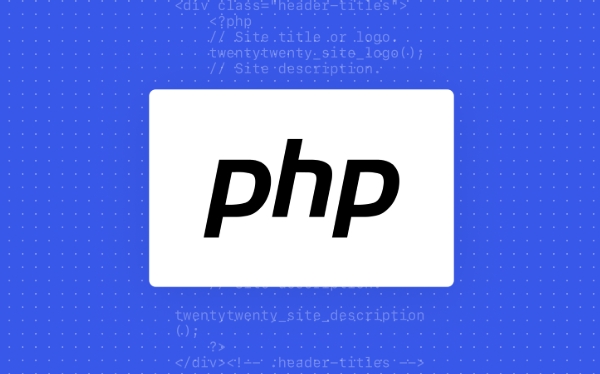 Backend Development
Backend Development
 PHP Tutorial
PHP Tutorial
 `break` vs. `continue`: A Definitive Guide to PHP Iteration Control
`break` vs. `continue`: A Definitive Guide to PHP Iteration Control
`break` vs. `continue`: A Definitive Guide to PHP Iteration Control
Aug 02, 2025 pm 04:31 PMbreak is used to exit the loop immediately and subsequent iterations will no longer be executed; 2. continue is used to skip the current iteration and continue to continue the next loop; 3. In nested loops, break and continue can be controlled to jump out of multiple layers with numerical parameters; 4. In actual applications, break is often used to terminate the search after finding the target, and continue is used to filter invalid data; 5. Avoid excessive use of break and continue, keep the loop logic clear and easy to read, and ultimately, it should be reasonably selected according to the scenario to improve code efficiency.

When working with loops in PHP—whether for , while , foreach , or do-while —you'll eventually need fine control over the flow. That's where break and continue come in. While they might seem similar at first glance, they serve very different purposes. Let's cut through the confusion with a clear, practical guide.

What break Does: Exit the Loop Immediately
The break statement stops the loop entirely, no matter how many iterations are left.
As soon as PHP encounters break , it jumps out of the loop and continues executing the code that follows.

Example:
for ($i = 1; $i <= 10; $i ) {
if ($i === 5) {
break;
}
echo $i . " ";
}
// Output: 1 2 3 4 Once $i hits 5, the loop terminates. The numbers 5 through 10 are never processed.

? Use break when you've found what you're looking for —like searching for a specific item in an array and wanting to stop as soon as it's found.
What continue : Skip to the Next Iteration
continue doesn't exit the loop. Instead, it skips the rest of the current iteration and jumps straight to the next one.
This is useful when you want to ignore certain values or conditions but keep looping.
Example:
for ($i = 1; $i <= 5; $i ) {
if ($i === 3) {
continue;
}
echo $i . " ";
}
// Output: 1 2 4 5 When $i is 3, continue kicks in. The echo statement is skipped, but the loop continues with $i = 4 .
? Use continue to filter out unwanted cases —like skipping invalid data in a dataset.
Using break and continue with Nested Loops
Both statements become more powerful (and a bit trickier) when dealing with nested loops.
You can optionally specify a numeric argument to control how many levels of loops to break out of or skip.
break 2; — Break Out of Two Loops
for ($i = 1; $i <= 3; $i ) {
for ($j = 1; $j <= 3; $j ) {
if ($i === 2 && $j === 2) {
break 2;
}
echo "i=$i, j=$j\n";
}
}Output:
i=1, j=1 i=1, j=2 i=1, j=3 i=2, j=1
As soon as i=2 and j=2 , break 2 exits both loops.
Similarly, continue 2 would skip to the next iteration of the outer loop.
Without a number, both
breakandcontinueaffect only the innermost loop.
Common Pitfalls & Best Practices
- ? Don't overuse
breakin long loops—it can make code harder to follow. - ? Use
breakwhen searching: once you find a match, there's no need to keep going. - ? Use
continueto handle edge cases early (eg, skip empty values). - ? Avoid deep nesting with multiple
break/continuestatements—it reduces readability. - ? Consider restructuring logic with functions or early returns if the loop gets too complex.
Real-World Use Cases
break in action: Find a user by ID
foreach ($users as $user) {
if ($user['id'] === $targetId) {
echo "Found: " . $user['name'];
break; // No need to check others
}
} continue in action: Process only active users
foreach ($users as $user) {
if (!$user['active']) {
continue; // Skip inactive users
}
sendEmail($user['email']);
}Basically, just remember:
-
break= “I'm done with this loop.” -
continue= “I'm done with this round—on to the next.”
They're simple tools, but using them wisely keeps your loops clean and efficient.
The above is the detailed content of `break` vs. `continue`: A Definitive Guide to PHP Iteration Control. For more information, please follow other related articles on the PHP Chinese website!

Hot AI Tools

Undress AI Tool
Undress images for free

Undresser.AI Undress
AI-powered app for creating realistic nude photos

AI Clothes Remover
Online AI tool for removing clothes from photos.

Clothoff.io
AI clothes remover

Video Face Swap
Swap faces in any video effortlessly with our completely free AI face swap tool!

Hot Article

Hot Tools

Notepad++7.3.1
Easy-to-use and free code editor

SublimeText3 Chinese version
Chinese version, very easy to use

Zend Studio 13.0.1
Powerful PHP integrated development environment

Dreamweaver CS6
Visual web development tools

SublimeText3 Mac version
God-level code editing software (SublimeText3)

Hot Topics
 php regex for password strength
Jul 03, 2025 am 10:33 AM
php regex for password strength
Jul 03, 2025 am 10:33 AM
To determine the strength of the password, it is necessary to combine regular and logical processing. The basic requirements include: 1. The length is no less than 8 digits; 2. At least containing lowercase letters, uppercase letters, and numbers; 3. Special character restrictions can be added; in terms of advanced aspects, continuous duplication of characters and incremental/decreasing sequences need to be avoided, which requires PHP function detection; at the same time, blacklists should be introduced to filter common weak passwords such as password and 123456; finally it is recommended to combine the zxcvbn library to improve the evaluation accuracy.
 PHP Variable Scope Explained
Jul 17, 2025 am 04:16 AM
PHP Variable Scope Explained
Jul 17, 2025 am 04:16 AM
Common problems and solutions for PHP variable scope include: 1. The global variable cannot be accessed within the function, and it needs to be passed in using the global keyword or parameter; 2. The static variable is declared with static, and it is only initialized once and the value is maintained between multiple calls; 3. Hyperglobal variables such as $_GET and $_POST can be used directly in any scope, but you need to pay attention to safe filtering; 4. Anonymous functions need to introduce parent scope variables through the use keyword, and when modifying external variables, you need to pass a reference. Mastering these rules can help avoid errors and improve code stability.
 How to handle File Uploads securely in PHP?
Jul 08, 2025 am 02:37 AM
How to handle File Uploads securely in PHP?
Jul 08, 2025 am 02:37 AM
To safely handle PHP file uploads, you need to verify the source and type, control the file name and path, set server restrictions, and process media files twice. 1. Verify the upload source to prevent CSRF through token and detect the real MIME type through finfo_file using whitelist control; 2. Rename the file to a random string and determine the extension to store it in a non-Web directory according to the detection type; 3. PHP configuration limits the upload size and temporary directory Nginx/Apache prohibits access to the upload directory; 4. The GD library resaves the pictures to clear potential malicious data.
 Commenting Out Code in PHP
Jul 18, 2025 am 04:57 AM
Commenting Out Code in PHP
Jul 18, 2025 am 04:57 AM
There are three common methods for PHP comment code: 1. Use // or # to block one line of code, and it is recommended to use //; 2. Use /.../ to wrap code blocks with multiple lines, which cannot be nested but can be crossed; 3. Combination skills comments such as using /if(){}/ to control logic blocks, or to improve efficiency with editor shortcut keys, you should pay attention to closing symbols and avoid nesting when using them.
 How Do Generators Work in PHP?
Jul 11, 2025 am 03:12 AM
How Do Generators Work in PHP?
Jul 11, 2025 am 03:12 AM
AgeneratorinPHPisamemory-efficientwaytoiterateoverlargedatasetsbyyieldingvaluesoneatatimeinsteadofreturningthemallatonce.1.Generatorsusetheyieldkeywordtoproducevaluesondemand,reducingmemoryusage.2.Theyareusefulforhandlingbigloops,readinglargefiles,or
 Tips for Writing PHP Comments
Jul 18, 2025 am 04:51 AM
Tips for Writing PHP Comments
Jul 18, 2025 am 04:51 AM
The key to writing PHP comments is to clarify the purpose and specifications. Comments should explain "why" rather than "what was done", avoiding redundancy or too simplicity. 1. Use a unified format, such as docblock (/*/) for class and method descriptions to improve readability and tool compatibility; 2. Emphasize the reasons behind the logic, such as why JS jumps need to be output manually; 3. Add an overview description before complex code, describe the process in steps, and help understand the overall idea; 4. Use TODO and FIXME rationally to mark to-do items and problems to facilitate subsequent tracking and collaboration. Good annotations can reduce communication costs and improve code maintenance efficiency.
 Quick PHP Installation Tutorial
Jul 18, 2025 am 04:52 AM
Quick PHP Installation Tutorial
Jul 18, 2025 am 04:52 AM
ToinstallPHPquickly,useXAMPPonWindowsorHomebrewonmacOS.1.OnWindows,downloadandinstallXAMPP,selectcomponents,startApache,andplacefilesinhtdocs.2.Alternatively,manuallyinstallPHPfromphp.netandsetupaserverlikeApache.3.OnmacOS,installHomebrew,thenrun'bre
 Learning PHP: A Beginner's Guide
Jul 18, 2025 am 04:54 AM
Learning PHP: A Beginner's Guide
Jul 18, 2025 am 04:54 AM
TolearnPHPeffectively,startbysettingupalocalserverenvironmentusingtoolslikeXAMPPandacodeeditorlikeVSCode.1)InstallXAMPPforApache,MySQL,andPHP.2)Useacodeeditorforsyntaxsupport.3)TestyoursetupwithasimplePHPfile.Next,learnPHPbasicsincludingvariables,ech





